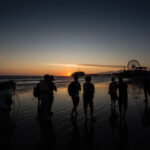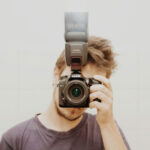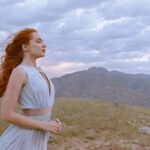Lighting and posing are two things that every successful portrait photographer has to learn. And though it may seem a bit complicated if you scan through tutorials, it doesn’t really need to be. In the video below, portrait photographer Daniel Norton gives us a super easy setup for casual portraits, a dramatic modeling type shot, and a fun image, all with just one or two lights and easy wardrobe/posing tips:
While some folks just set up the lights, put a model in front of them, and start clicking, more serious photographers know that putting a little thought into the camera angles, lighting, and posing before you shoot is the key to getting consistently great shots. At the same time, it’s not rocket science—it’s a lot less complex than many tutorials would have you think. Here are Norton’s tips and tricks on preparing for three different types of portraits: the casual portrait, the dramatic, formal portrait, and the fun, zany portrait.
The Casual Shot
The casual shot is intended to convey a sense of ease and relaxation—the proverbial space where one feels free to “let their hair down.”
Wardrobe: Soft, relaxed attire. Sweaters, rolled up jeans, vibrant colors. Things you’d wear at home or among friends.
Lighting: Here Norton mimics window light with a Profoto silver umbrella. Nothing too extreme and no bold shadows. Just a large swath of soft light. Everything is set on a white background to aid in the “sunny” or light feeling.
Posing: Relaxed and casual. Again, something you’d see at home or among friends. Norton recommends shooting on the floor for these shots. Not only does this amplify the casualness of the shot, but it avoids any awkwardness that might happen while standing.
Camera Position: In most cases it should be even with model. Avoid shooting down on her. At the same time, don’t get so low so that you’re looking up her nostrils.
The Fashion Shot
The fashion shot is much more formal. It uses a bit more drama in the lighting and focuses more on setting off both the model and the clothing.
Wardrobe: Formal attire, something that you want the viewer to notice/focus on.
Lighting: To create drama in this portrait Norton uses two Profoto beauty dishes, one in the front and one to set the model off from the background (which is black). He uses grids to control the light and make just the right shadows.
Posing: Here we’re looking for strong, powerful poses. The model needs to be standing, both for the drama of the shot, but also to make sure the dress is seen.
Camera Position: Norton suggests holding the camera at waist level at around 70mm on your lens. (He’s using a Canon 24-70mm f/2.8.)
Personality Shot
The personality shot is a lot looser than the previous two. It’s meant to convey a bit of fun and/or personality. It’s great for musicians or other performers who want their portrait to say a bit about them.
Wardrobe: Casual and/or fun dress. Something that brings out a bit more of the story you want to tell with the portrait.
Lighting: Reflective with unusual shadows. In this shot Norton combines two white flats in a 90 degree angle to add a twist to the shot. For creating the shadows he’s using a Profoto OCF SoftBox 2×3 with a grid pointed a bit away from her. Most of the light that’s hitting her is reflected.
Posing: Whatever tells the story you want to convey.
Camera Position: This will vary with the type of shot you’re looking for.
All in all, all three of these portrait styles can be lit and shot with a fair amount of ease. All you need is a camera, a key light (and background light if shooting fashion shots), a good background, and a great model. Simple!
Like This Article?
Don't Miss The Next One!
Join over 100,000 photographers of all experience levels who receive our free photography tips and articles to stay current:









Leave a Reply